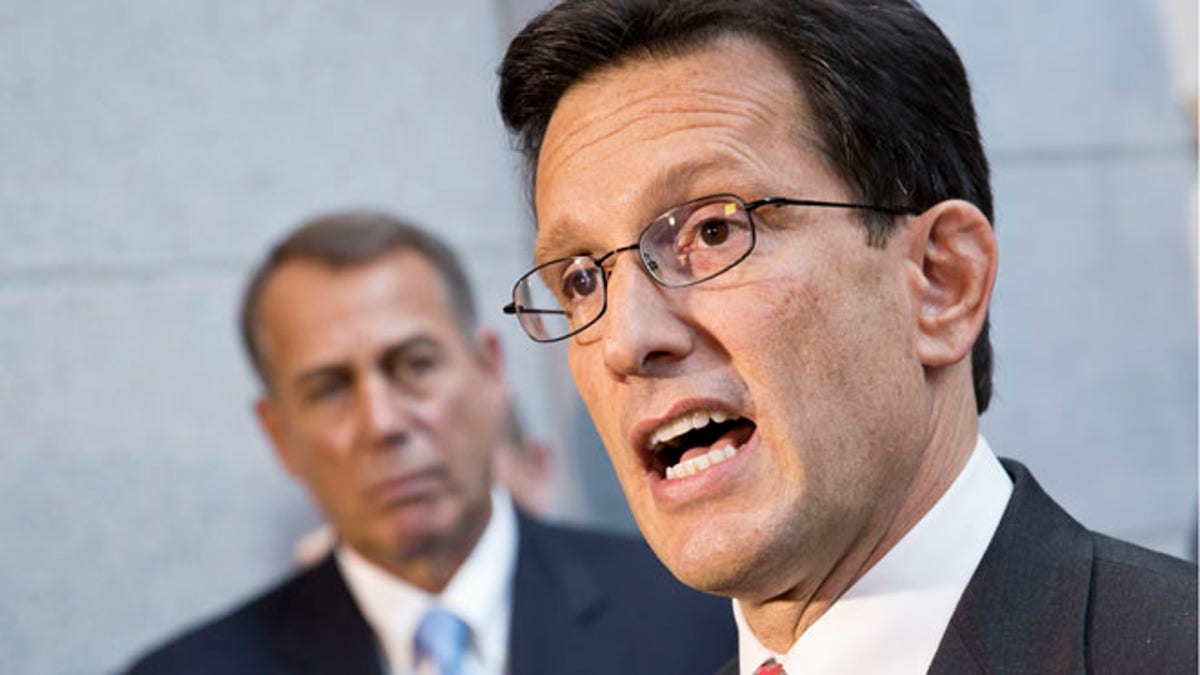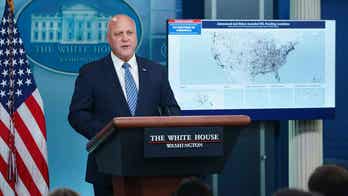
Oct. 15, 2013 - House Majority Leader Eric Cantor, R-Va., with House GOP leaders, speaks with reporters following a Republican strategy session, at the Capitol in Washington on Tuesday. At left is Speaker of the House John Boehner, R-Ohio. (AP)
With a House budget plan falling apart late Tuesday and Senate negotiators trying to restart talks, the U.S. could very well blow past the debt ceiling deadline because of timing on Thursday -- and the partial government shutdown could remain in effect until early next week.
This is all very subject to change and could move at a moment’s notice.
But this is the best we have so far, cobbled together from emails from various aides with knowledge of the situation and a conversation with Senate Majority Whip Dick Durbin, D-Ill..
When asked if Senate Majority Leader Harry Reid, D-Nev., might file the first round of cloture Tuesday night to initiate the process, which means the vote wouldn’t happen until Thursday at the earliest, Durbin said “I don’t think so.”
But senior aides suggested otherwise just to get the ball rolling.
One senior aide walked Fox News through the entire process if they have to use all procedural traps, which could involve two cloture hurdles. Shift all days one day later if Reid does not file cloture this evening.
First, they have to pick which legislative vehicle to use. It could be a bill passed already passed by the House. Article I, Section 7 of the Constitution dictates that “revenue” related bills must start in the House.
So the Senate could conceivably take a House-created measure which is now in the Senate, strip it out and insert the new language which Reid and Senate Minority Leader Mitch McConnell, R-Ky., have settled on.
Cloture petitions need two days to ripen before the Senate may consider them.
So that means the first cloture vote would occur Thursday at the earliest. It would require 60 yeas.
If the Senate gets 60 yeas, opponents then have the right to burn off an additional 30 hours of time before the Senate may “proceed” to the actual bill. That gets us to Friday evening, Oct. 18.
On Friday evening, the Senate may then start on the actual bill. Reid will do two things at that point. He will alter the bill by filing amendments which constitute his agreement with McConnell. Then Reid files another cloture petition to finish all debate on the entire bill. That cloture petition won’t ripen for a vote until Sunday, Oct. 20.
On Sunday, the Senate would consider the amendments, formally changing the original, House passed bill with the Reid/McConnell language and vote to end all debate via the second cloture petition. That also needs 60 votes.
If they get 60 yeas, opponents of the bill then get an additional 30 hours. That gets us to Monday, Oct. 21. On that day, the Senate may vote, up or down, on the final agreement. It needs 51 yeas.
If it passes, it goes to the House.
Presumably, the House would try to act on this as quickly as possible, on Oct. 21. The House would have to go to the Rules Committee and tee up the legislation for the floor.
It could do this all in one day and pass the final agreement later on the 21st. The House would probably pass the measure with some Republicans and a lot of Democrats.
The model for this is the vote in January on aid for Hurricane Sandy. The House approved it 241-180, but with only 49 Republican yeas and a robust 192 Democratic yeas.
I asked Durbin what he thinks would happen in the House this week or next.
“After what I saw tonight, I won’t predict what would happen there,” Durbin said.
Notably, the Social Security Administration needs to send out a $12 billion payment to its recipients on Oct. 23. So this gets the agreement in just under the wire.
All of this could be accelerated if the Senate is able to get unanimous consent to speed up the process. Unanimous consent is where all senators come together and agree to do something.
These are unique circumstances and that could happen, especially with the debt limit scheduled to hit Thursday. In addition, some of the chunks of the 30 hour blocks could be yielded back as well.
Still, there is a wild card in all of this.
Earlier this year, the Senate slightly tweaked the chamber’s filibuster rules. This is called “bipartisan cloture.” When filing a cloture petition, it’s necessary for the leader to get the signatures of 16 senators. The vote actually requires 60 yeas.
But the structure of the cloture petition is different. The majority and minority leaders must sign the petition and cobble together a bipartisan group of 14 senators from both bodies.
Most cloture petitions have to sit for two nights to “ripen” before the Senate may consider them. But this one only entails one night. Under conventional cloture rules, opponents of stopping debate get 30 hours once cloture is invoked. But under “bipartisan cloture,” the Senate can then skip immediately to the bill or a final vote.
“Bipartisan cloture” is brand new. It’s a byproduct of efforts earlier this year to curb some filibusters. And as a result, it’s never been used.
Deploying “bipartisan cloture” could certainly hasten the process, potentially lopping off a day or two.
And it would be precedent setting.
“Bipartisan cloture” at the front, on the motion to proceed, could shave a lot of time off the process. I am told that they are prepping a scenario for this.
Another knowledgeable source tells Fox that regardless when Reid files cloture, he could get unanimous consent to blow off one of the rounds of cloture so the Senate can take its final vote on Thursday, Oct. 17 and kick it to the House.
That forces the House to act that day, or as the source put it Boehner “owns the 1,000 point drop on the Dow.”




